Posts Tagged by matt anderson
Exploring the Depths of Our Collections
Preserving the past is resource-intensive, and The Henry Ford actively seeks grant funding to support its mission "to provide unique educational experiences based on authentic objects, stories, and lives from America's traditions of ingenuity, resourcefulness, and innovation." Some of these grants focus on enhancing collections storage, stewardship, and accessibility — both physical and virtual. In late summer 2024, the Institute of Museum and Library Services (IMLS) awarded The Henry Ford a two-year grant to clean, rehouse, and create digital records for artifacts related to power and energy, mobility and transportation, and communications and information technology.
Building on the progress made by previous grants, this project will focus on approximately 325 artifacts housed in The Henry Ford's Central Storage Building that require attention in these key areas. The Henry Ford is currently investing in upgrades to the HVAC system in the building, which will improve the ability to regulate the storage environment. In conjunction with those improvements, the grant work will address overcrowding and previous environmental issues, which in some cases have led to dirt, mold, and other forms of artifact deterioration. Each artifact will be moved, cleaned, and assessed for conservation needs. Registrar staff will update or create catalog records, working closely with curatorial staff to research additional context.
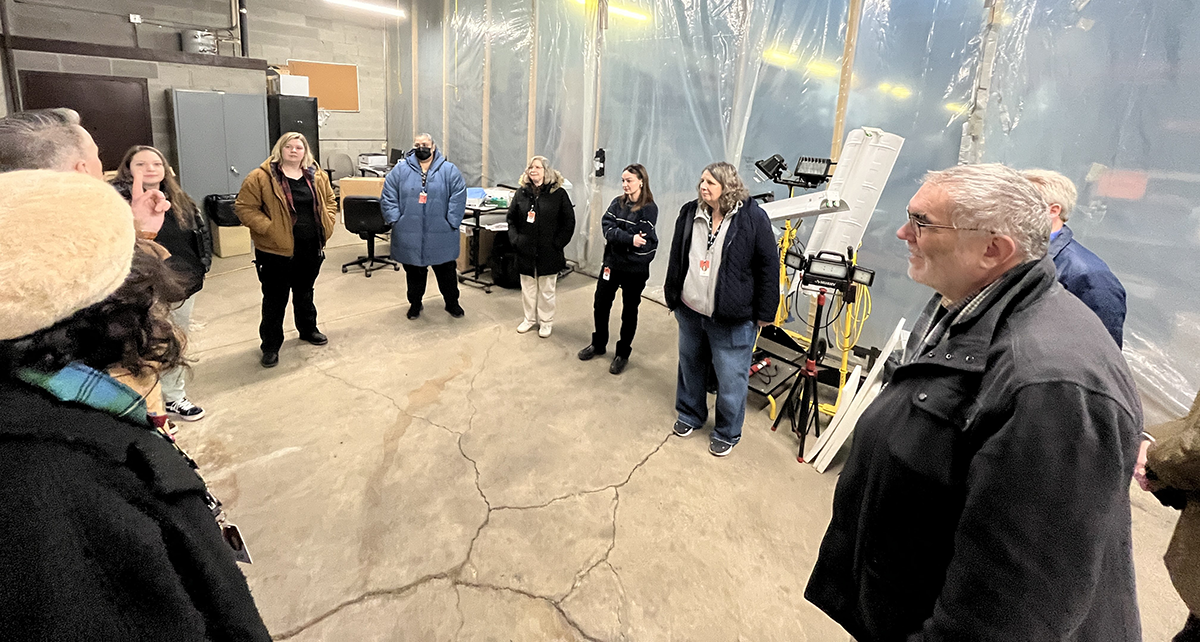
IMLS grant team members meet to discuss work progress. / Photo by Aimee Burpee
Of the 325 artifacts, about 100 priority artifacts identified by the curators will undergo conservation treatment to digitization standards, will be photographed at high resolution and made available online through The Henry Ford's Digital Collections. Curators and associate curators will create digital content, such as blog posts, to highlight these artifacts. Additionally, curatorial staff will write descriptive narratives for the website, providing essential historical context for public audiences.
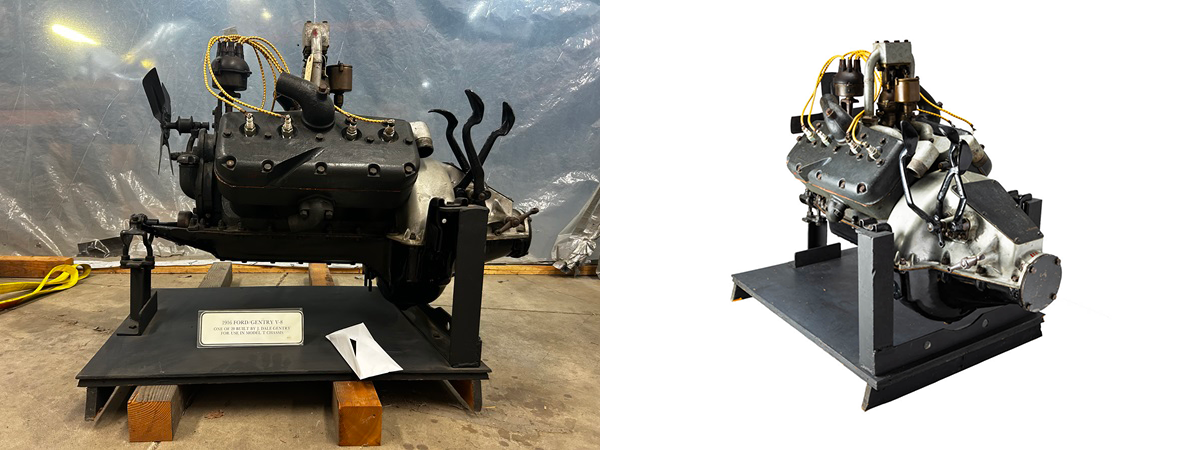
The IMLS Collections Specialist takes a reference image of each artifact for the catalog record, such as this 1915 Gentry and Lewis V-8 Automobile Engine for the Model T (left), then, after conservation intervention, Photography Studio staff photographs this priority artifact for publication on digital collections. / Photo by Colleen Sikorski (left), THF802658 (right)
Work on the grant began in the fall of 2024, and the first priority artifact to be conserved is a six-cylinder General Motors 6-71 diesel engine — a legend in its own right. Introduced by General Motors' diesel engine division in 1938, the two-stroke unit powered everything from farm tractors and stationary generators to trucks and buses (including the 1948 GM bus on which Rosa Parks made her historic stand). GM produced variants with two, three, four, six, eight, twelve, sixteen, and twenty-four cylinders, practically guaranteeing there was a Detroit Diesel in whatever size and with whatever horsepower a customer required.
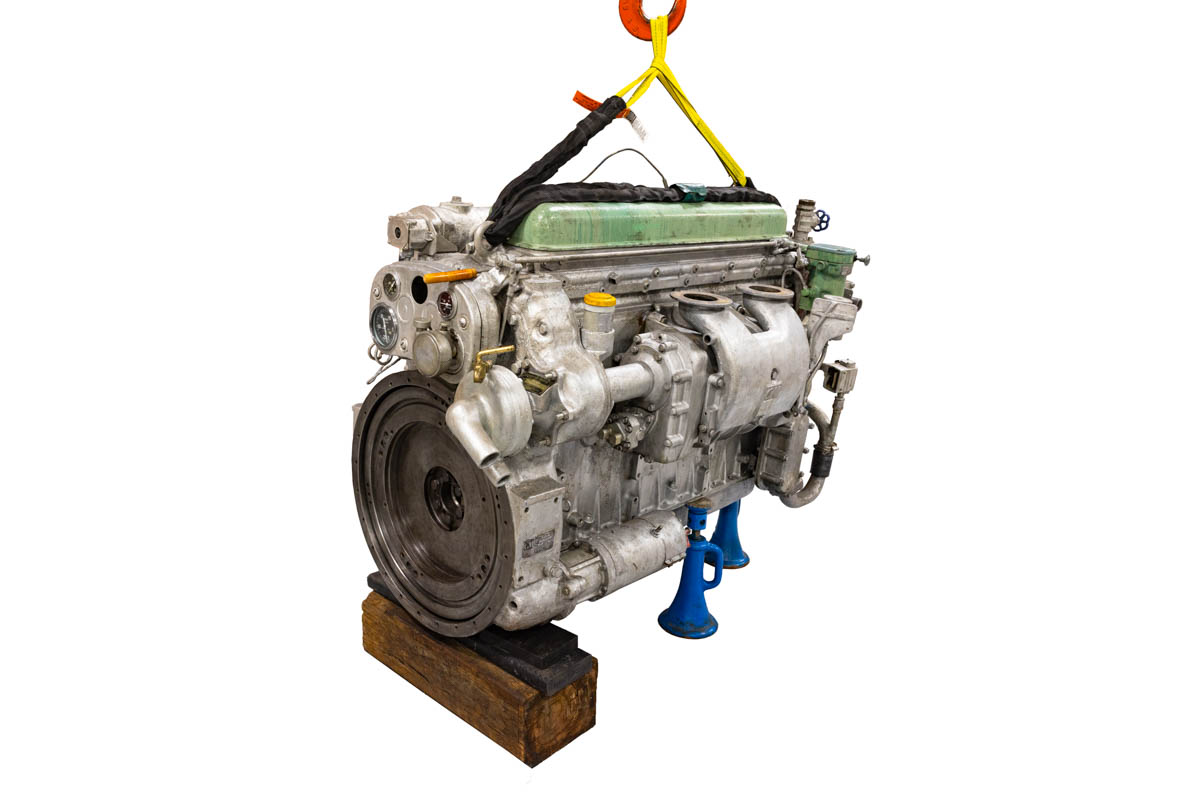
For 40 years, this GM 6-71 engine provided faithful service aboard Jacques Cousteau's ship Calypso / THF802646
The Henry Ford's Detroit Diesel just so happened to be used on one of the most celebrated scientific vessels of the 20th century: Calypso, the former World War II minesweeper converted into a floating laboratory by French oceanographer Jacques Cousteau. From 1950 through 1997, Calypso traveled the world's oceans for Cousteau's research, and for shooting many of his documentary television series and films. Calypso even visited the Great Lakes in 1980, when it traveled from the mouth of the St. Lawrence River to Duluth, Minnesota, some 2,300 miles away.
It's important to note that The Henry Ford's engine was not Calypso's source of propulsion. The ship's propellers were driven by two eight-cylinder General Motors diesel engines. Our six-cylinder engine was one of two units that ran the generators that produced electricity. Our engine didn't make the boat go, but it kept the lights on — arguably just as important a task. Of course, it wasn't just lights. Calypso's electric generators powered pumps, hydraulic systems, steering mechanisms, radar and navigation devices, and video equipment, among other necessities.
By the time our engine was decommissioned in 1981, it had been used on Calypso for 40 years, with an estimated 100,000 service hours under its belt. Calypso received two brand-new Detroit Diesel engines as part of a wider refurbishment in anticipation of a voyage to the Amazon River. General Motors gifted the decommissioned engine to The Henry Ford in 1986.
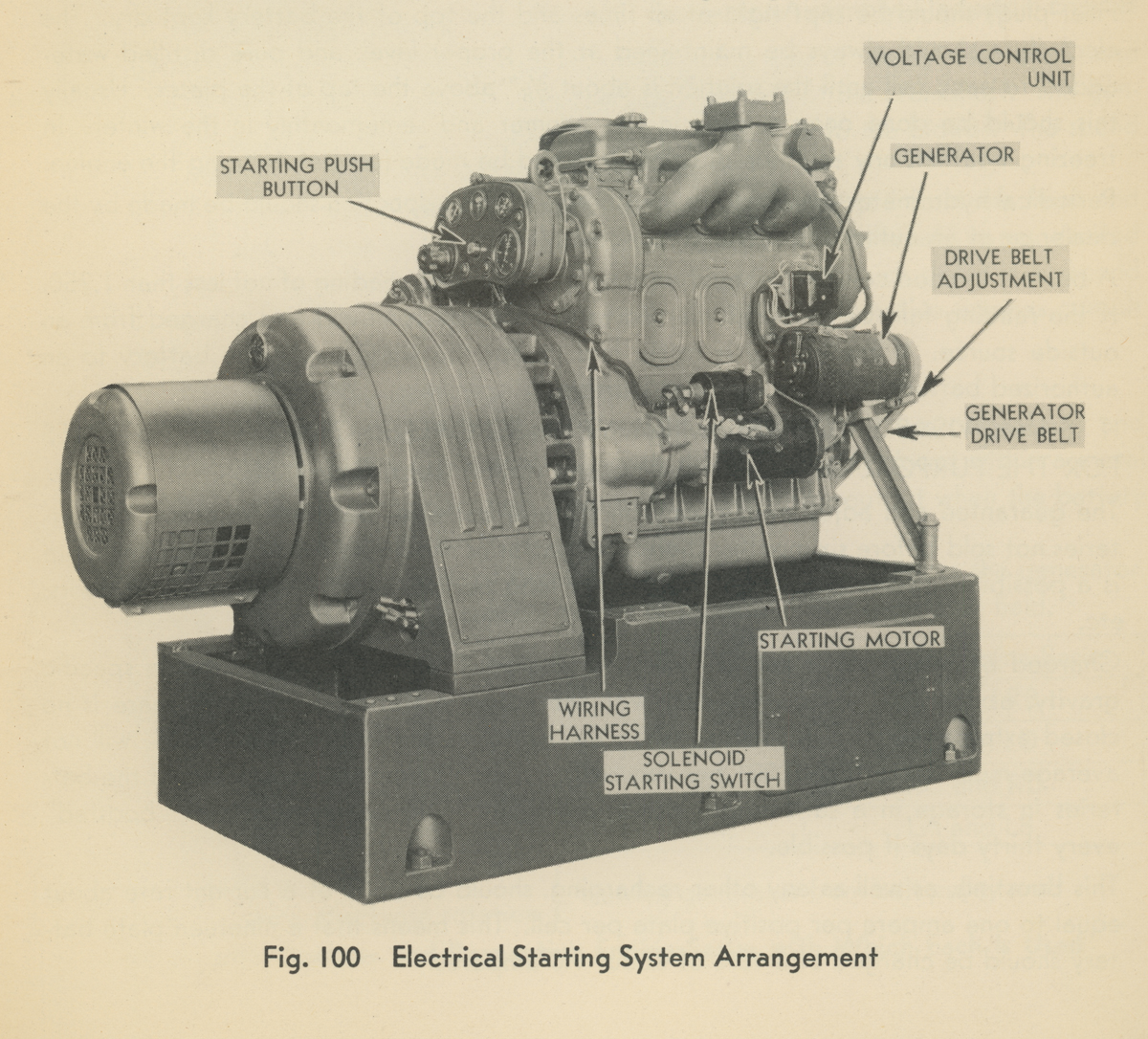
Vintage illustrations, like this one from a 1939 GM manual, guided efforts to conserve the Calypso engine. / THF721888
Through the IMLS grant project, conservators were able to clean the engine of accumulated dirt and dust, treat worn paint, and stabilize damaged gauges and controls. We were also able to replace a long-missing panel surrounding the starter button. Using period General Motors catalogs and manuals in the Benson Ford Research Center, we were able to design and 3D-print a new surround. Once the panel was painted to match, it became visually indistinguishable from the engine's original metal components. (Conservator notes, and inscriptions on the pieces themselves, identify replacement parts so as not to cause confusion in the future.) With that work done, the engine was photographed and given a new and much improved set of digital images on the website.
The Calypso Detroit Diesel is only the first of many important artifacts that will benefit from the IMLS grant and our ongoing work in the Central Storage Building. Stay tuned for future stories. It's a project that promises to be its own voyage of discovery.
This blog was produced by Matt Anderson, Curator of Transportation, and Aimee Burpee, Associate Curator at The Henry Ford.
Hands-On History at the Texaco Service Station Experience
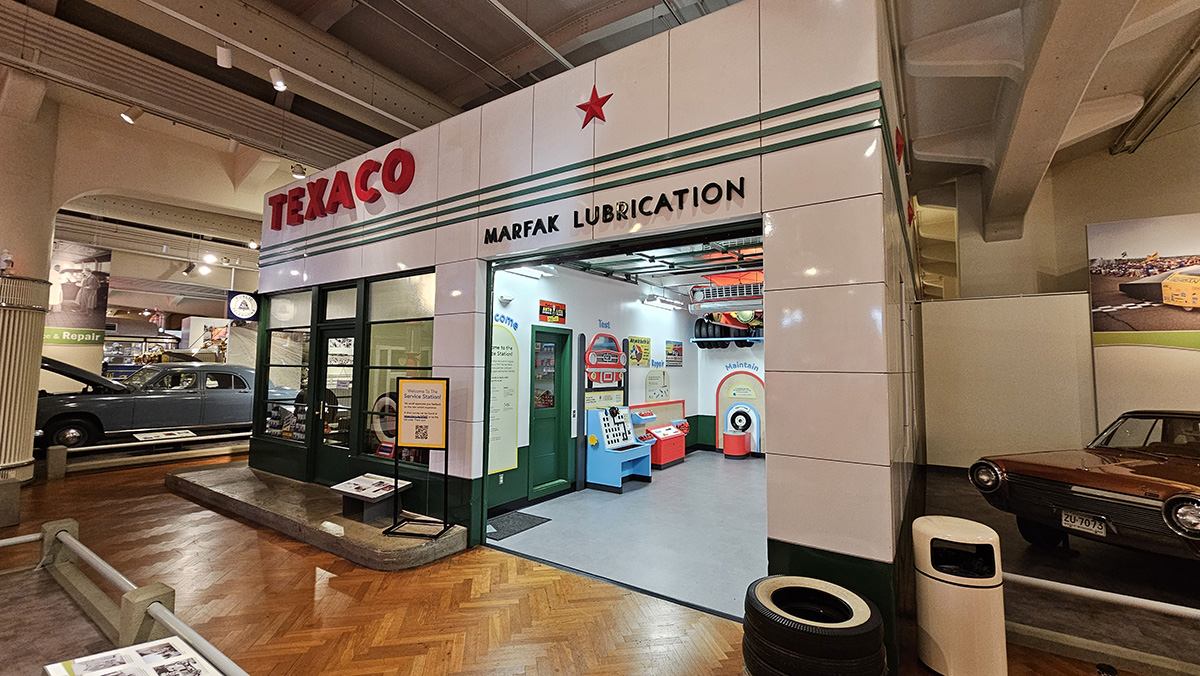
All-new interactives await guests of all ages and abilities in the reimagined Texaco Service Station Experience. / Photo by Matt Anderson
Young visitors to The Henry Ford will find a new group of interactive experiences in the reimagined service garage at our Texaco Service Station. Thanks to a grant from the Michigan Arts and Culture Council, we've been able to redesign and reopen this space that had been closed since 2018. Our Texaco Service Station Experience is more inclusive and accessible than ever before, with activities geared to guests of all abilities and varying age groups.
The new interactives are based on the actual work that took place in automotive service garages across the United States throughout the mid-20th century. Each activity is rooted in Model i, The Henry Ford's signature learning framework focusing on the actions and habits of innovators. Six concepts are highlighted in the garage: Diagnose, Assemble, Inspect, Maintain, Repair and Test.
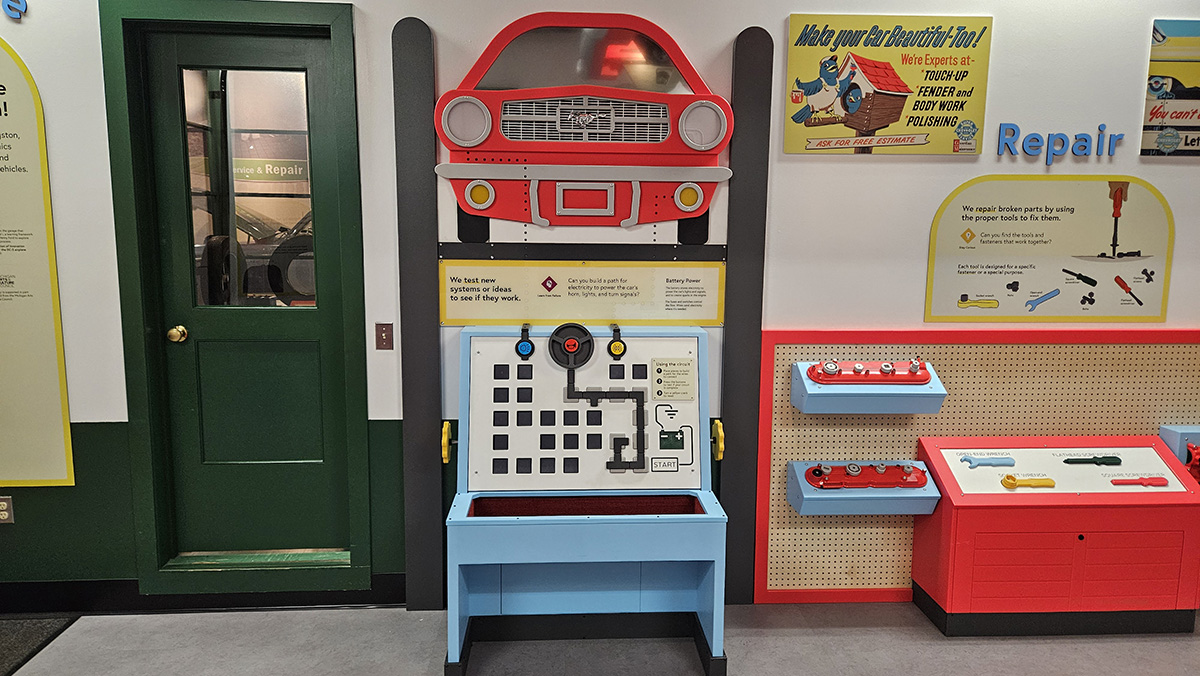
Guests build electrical circuits and find the right tool for the job in the Test and Repair interactives. / Photo by Matt Anderson
“Test” is centered on the electrical systems that power everything from a car's spark plugs to its horn. In this activity, guests make an electrical circuit using puzzle pieces connecting the battery with the horn, headlights and turn signals. Build the circuit correctly and you’ll see these various components work. But if they don't power up as expected, then you can go back to your circuit to find and fix the wrong puzzle pieces. Next to “Test” is the “Repair” station, where visitors discover valve covers with various fasteners. The challenge is to match nuts, bolts and screws with the tools that fit them, whether it's an open-end wrench, a socket wrench or a flathead or square screwdriver.
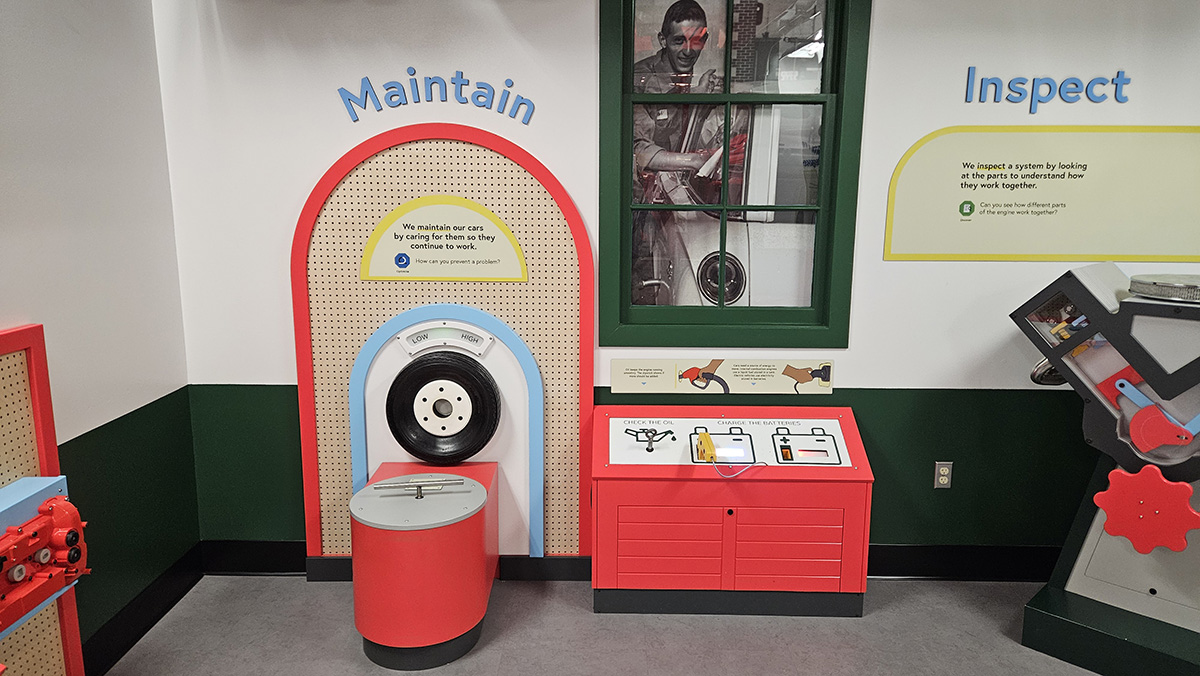
Guests can perform routine maintenance tasks like checking tire pressure or oil level. / Photo by Matt Anderson
The “Maintain” activity contains three routine maintenance tasks familiar to any driver: checking tire pressure, oil level and battery charge. Guests push down on a T-handle plunger and watch a tire pressure gauge as it moves between "low" and "high." When the center of the gauge lights up, you know you've got it right. Pull on a dipstick to check engine oil and you're rewarded with an amusing slide whistle glissando. And in a nod to the growing popularity of electric vehicles, guests can charge a pair of EV batteries using a paddle charger inspired by the type used with the General Motors EV1.
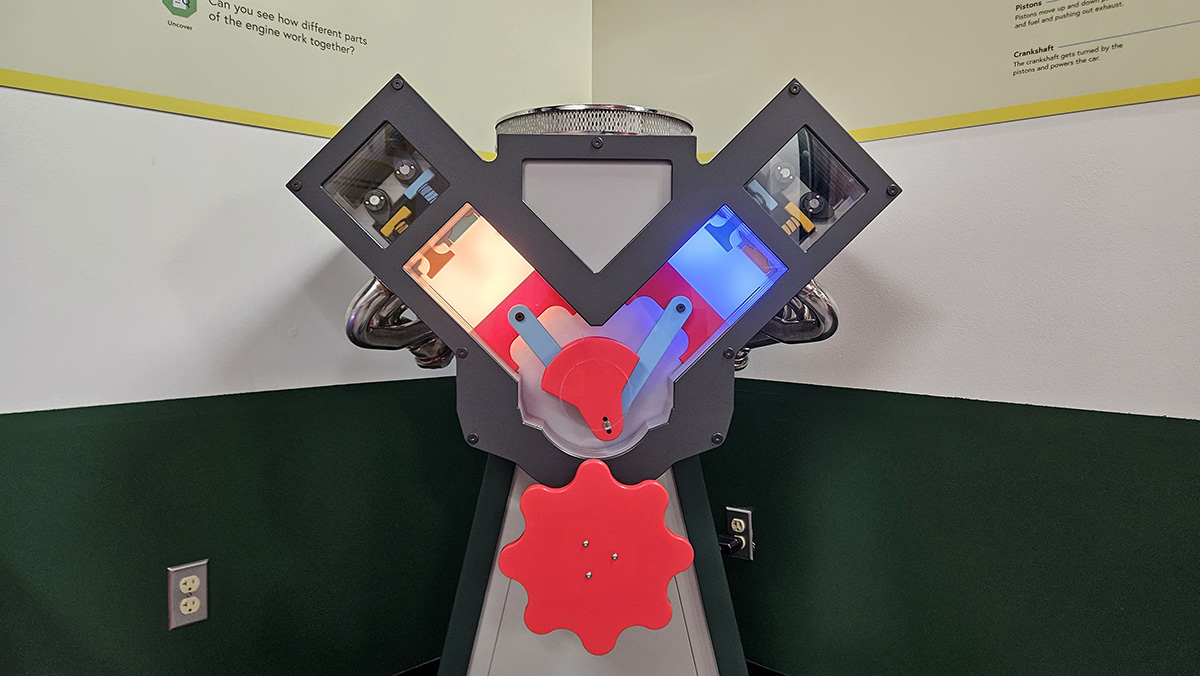
The basic workings of a four-stroke internal combustion engine are shown by this cutaway model. / Photo by Matt Anderson
The "Inspect" area includes an interactive that might appeal to adults as much as to children. We've created a cutaway model of a V-8 engine. Spin the red dial under the crankshaft and you can watch as pistons move up and down and valves open and close. What’s more, colored lights flash in sequence to illustrate ignition and exhaust within the two visible cylinders. As sophisticated as modern internal combustion engines are, most still use the same four-stoke cycle developed by Nikolaus Otto in the 1870s.
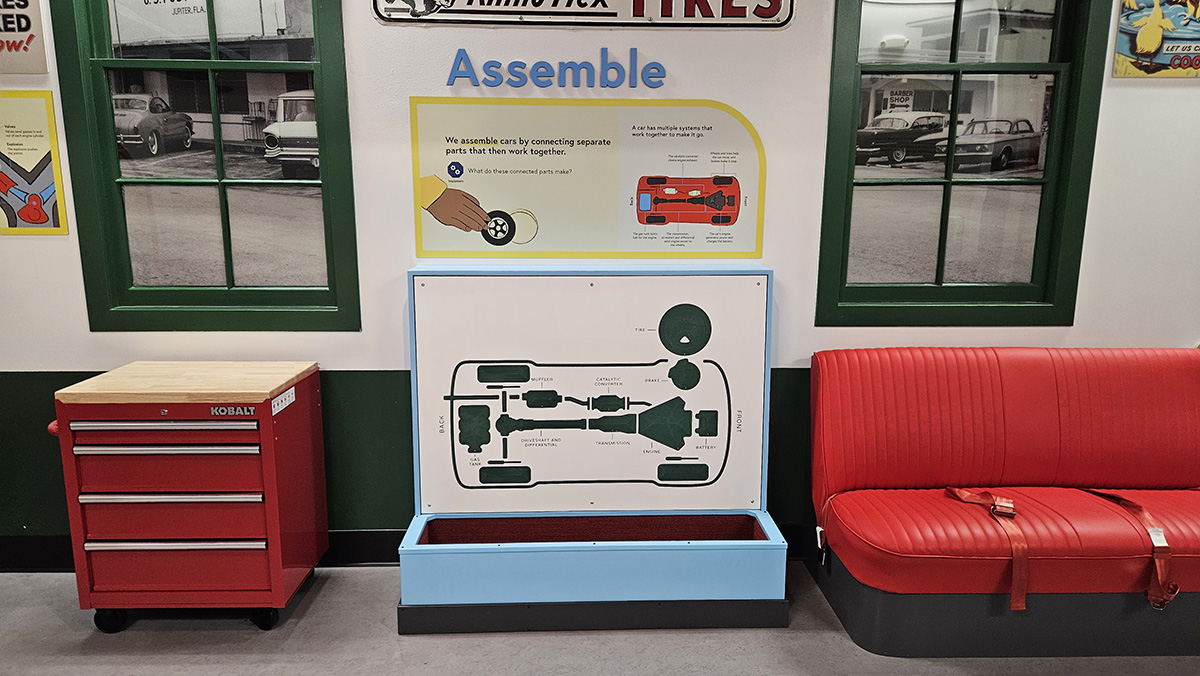
Guests assemble major automobile components in this puzzle activity. / Photo by Matt Anderson
Automobiles depend on multiple systems that work together to move the car. Young visitors discover some of the more significant ones in the service station's “Assemble” zone. Large puzzle pieces represent things like the engine, battery, driveshaft, muffler and tires on a typical car. Moving these pieces into their proper locations helps to show how they all work together to keep motorists moving down the road.
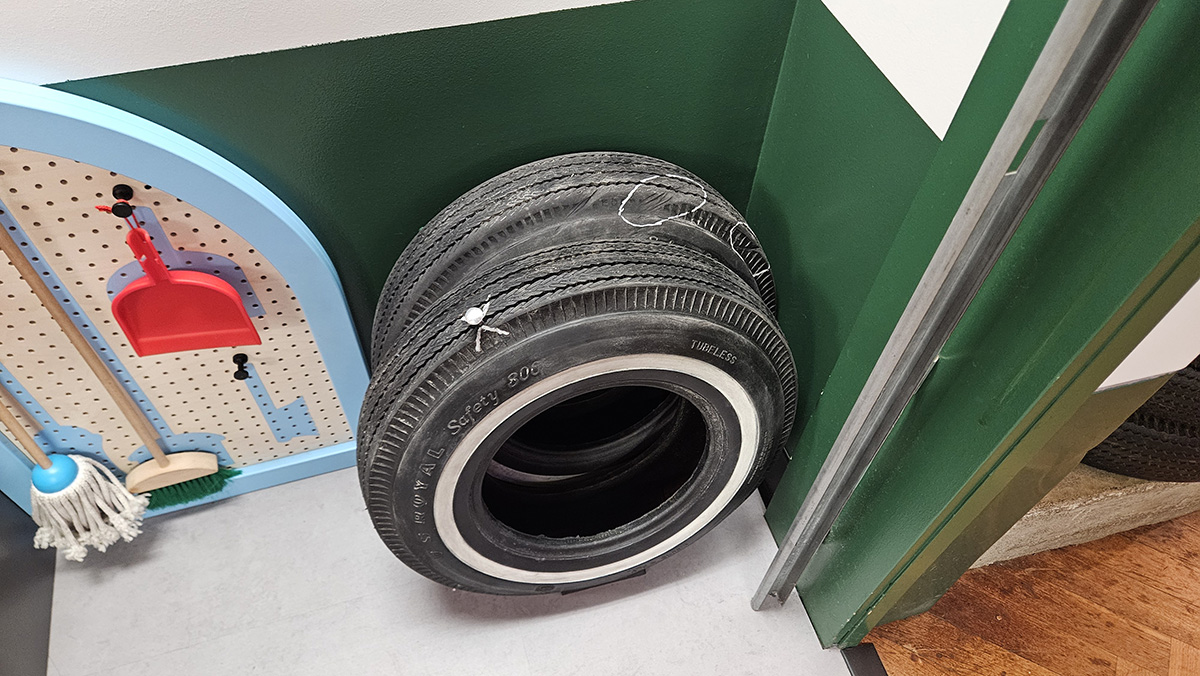
Youngsters can examine worn tire treads at this interactive station. / Photo by Matt Anderson
The station's "Diagnose" area is where the rubber meets the road. Children are invited to inspect a set of tires, looking for damage like a puncture from a nail or wear to the tread. This activity is a good reminder that today's highly reliable cars and trucks still depend on components that wear out with use and need replacing.
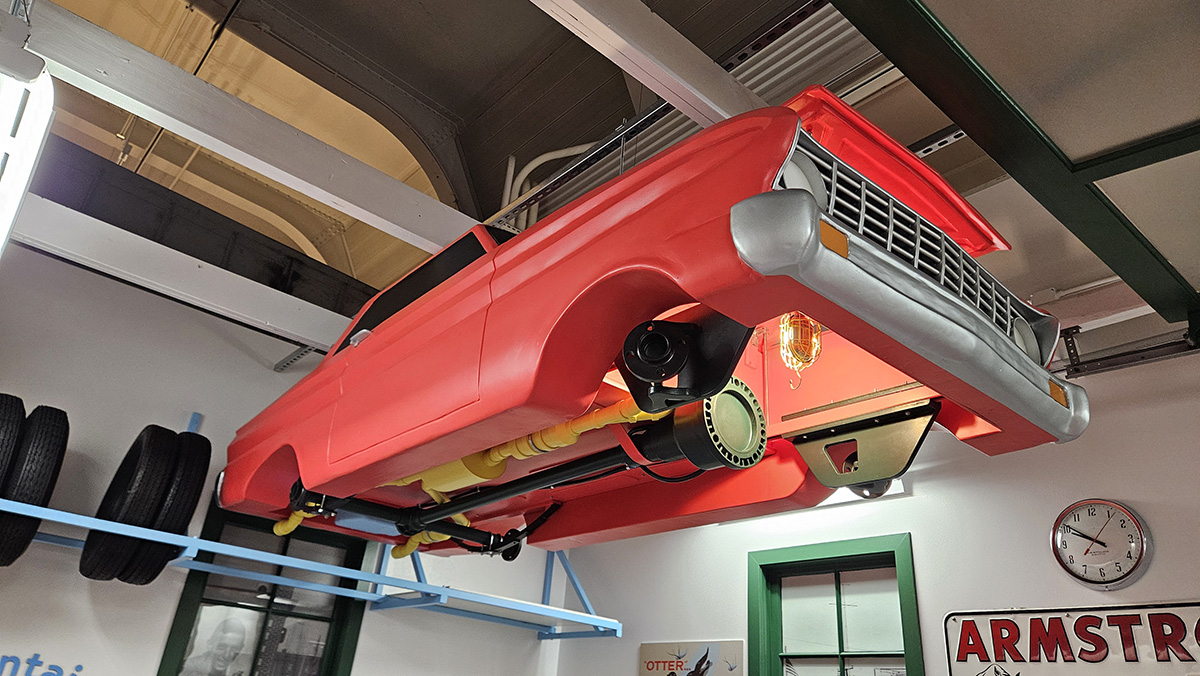
This scaled-down 1964 Ford Falcon replica hangs over the garage, allowing young visitors to see the car's undercarriage. / Photo by Matt Anderson
Visitors might recognize an old favorite returning from the previous version of the Texaco garage. Our scaled-down replica of a 1964 Ford Falcon, which previously sat on the garage floor, now hangs from the ceiling as if raised on a lift. This new placement lets visitors get a look at the car's undercarriage, as well as major components like the drivetrain and exhaust system. It all neatly mirrors the nearby "Assemble" puzzle activity.
Each of these new interactives was conceived, designed and built based on guest feedback and guidance from The Henry Ford's own accessibility advisory group. The activities bring new ideas and educational opportunities to the Texaco garage, and they make more efficient and effective use of the space. We're eager to share the reimagined Texaco Service Station Experience with everyone.
Matt Anderson is Curator of Transportation at The Henry Ford.
Celebrating the Chrysler Centennial at Old Car Festival 2024
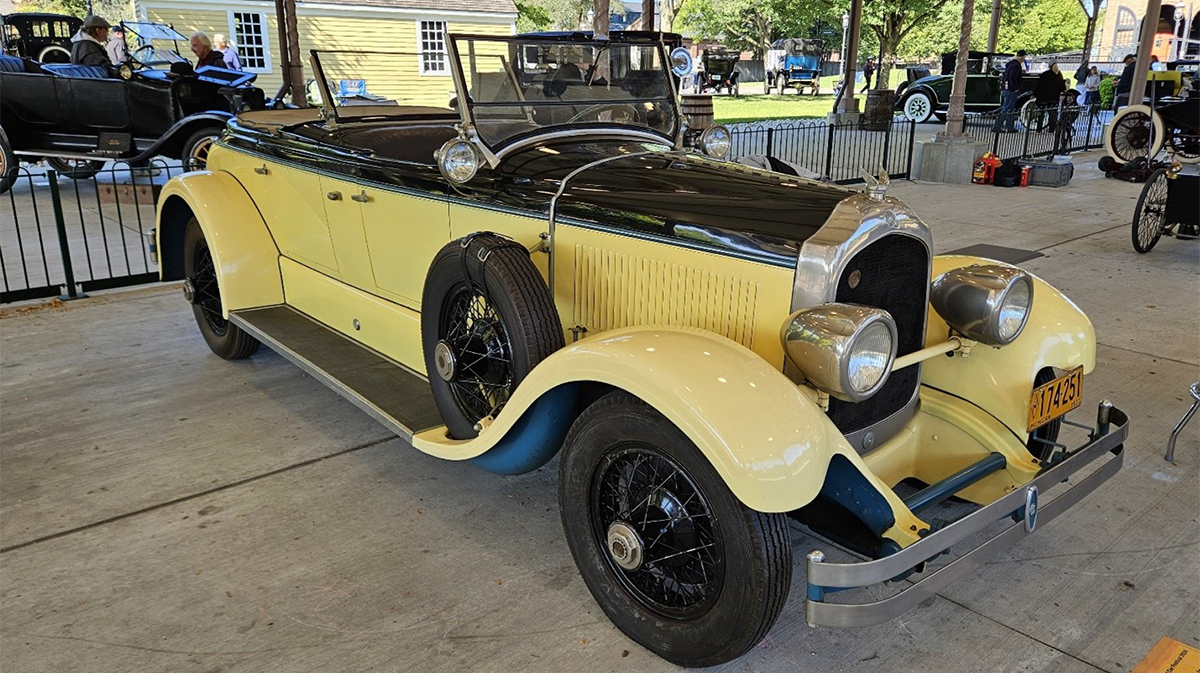
Chrysler cars, like this 1927 Imperial Sportif from The Henry Ford’s collection, were honored at this year’s Old Car Festival. / Photo by Matt Anderson
Automotive enthusiasts, history lovers, and folks just looking to have a good time descended on Greenfield Village on September 7-8, 2024, for Old Car Festival, our annual celebration of early American motoring circa 1900 to 1932. Nearly 750 cars, trucks, motorcycles, fire engines, and bicycles gathered for the show favored with sunny skies and fall-like temperatures. Attendees enjoyed good food, entertaining music and programs, and the incomparable kinetic energy of all those early gas, steam, and electric vehicles motoring through the village.
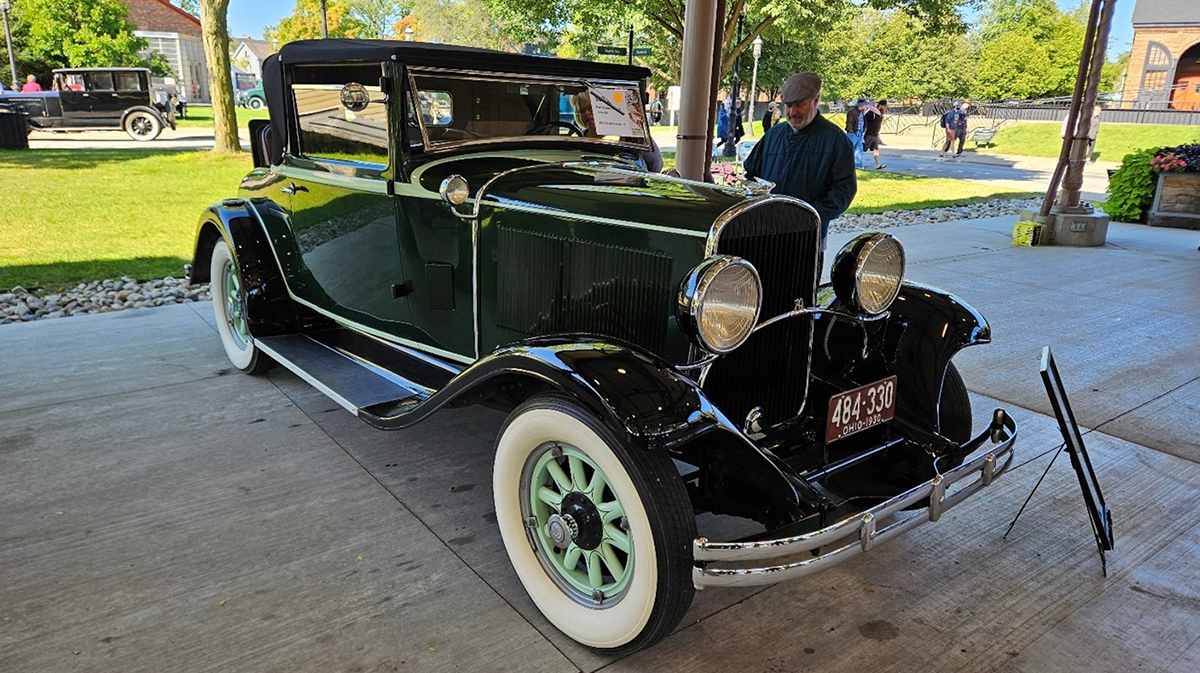
This 1930 Chrysler Series 70 was among the vehicles highlighted in Detroit Central Market. / Photo by Matt Anderson
Each year at Old Car Festival we honor a specific make or model, or we celebrate a significant anniversary. Considering that Walter P. Chrysler introduced the first Chrysler-badged cars in 1924, the Chrysler Centennial was an obvious choice for our 2024 theme. Chrysler got his start as a railroad machinist, but his abilities and industry contacts led to a job as Buick’s production head in 1911. Chrysler grew frustrated with General Motors boss William C. Durant – who enjoyed building corporations more than cars – and left in 1919. Never one to sit still, Chrysler reinvented himself as a turnaround manager, first at ailing Willys-Overland then at Maxwell. Chrysler effectively transformed Maxwell into his own Chrysler Corporation, and within five years he expanded it into a full-line automaker by purchasing Dodge Brothers and introducing mid-priced DeSoto and low-priced Plymouth.
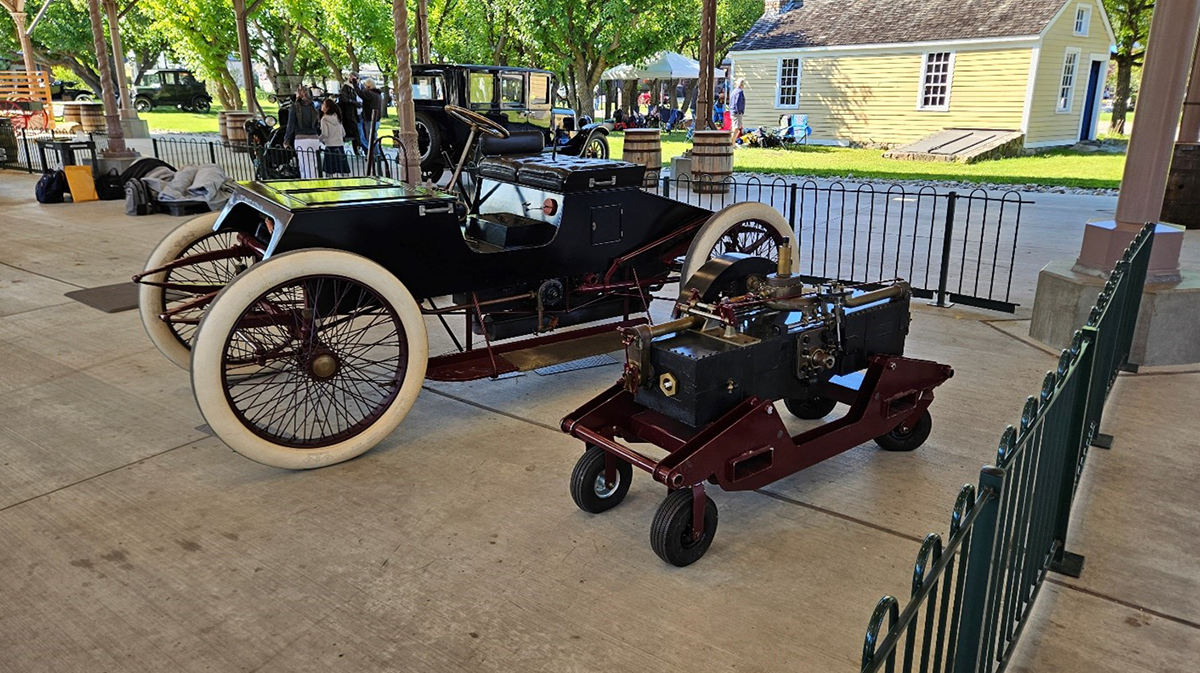
Our operating replica of Henry Ford’s 1901 “Sweepstakes” race car was in Detroit Central Market, alongside a separate copy of its 2-cylinder, 539-cubic-inch engine. / Photo by Matt Anderson
We honored Chrysler the man as much as Chrysler the company with a display in Detroit Central Market that covered all phases of his career. Several Old Car Festival participants kindly lent their own cars to the exhibit including a 1913 Buick 31, a 1920 Overland 4, a 1925 Maxwell 25-C, and various Chrysler models from 1927 to 1931 (including The Henry Ford’s own 1927 Chrysler Imperial Sportif). The special display was rounded out with a 1931 Plymouth PA and a 1932 Dodge Brothers DL.
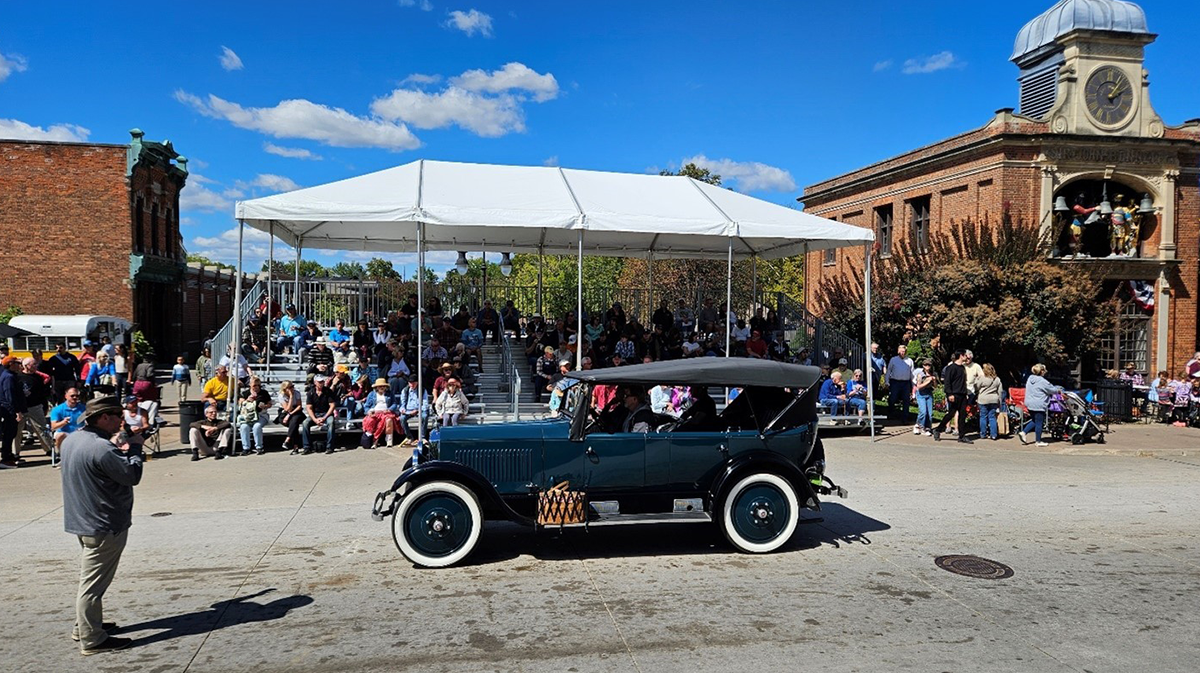
Narrated pass-in-review sessions provided a moment in the spotlight for participating cars, like this 1923 Studebaker Big Six. / Photo by Matt Anderson
For those who preferred to let the action come to them, Old Car Festival included several pass-in-review programs on Saturday and Sunday. Attendees could grab a seat in the bleachers and listen as experts like Andrew Beckman, archivist at the Studebaker National Museum, and Derek Moore, curator of collections at the Lane Motor Museum, provided commentary on passing vehicles. Folks interested in pedal-powered transportation could listen as bicycle historian Bill Smith narrated programs featuring high-wheel and safety bikes from the mid-19th century into the early 20th century.

The corner of Maple and Post hosted a Ford Model T pickup and Model A roadster alongside a 1925 Franklin sedan and a 1931 Chevrolet pickup. / Photo by Matt Anderson
Beyond pass-in-review, the weekend included two special presentations in Martha-Mary Chapel. Bob Casey, retired curator of transportation at The Henry Ford, spoke about Fred Zeder, Owen Skelton and Carl Breer, the “Three Musketeers” who designed the first of Walter Chrysler’s eponymous cars – and many more thereafter. Andy Dervan, a volunteer with our Benson Ford Research Center, presented on Ford Times, Ford Motor Company’s promotional magazine published from 1908 to 1917. Meanwhile, roadside America historian Daniel Hershberger literally set up camp near Scotch Settlement School where he presented on early auto camping throughout the weekend.

Acetylene lamps like those on this 1911 Metz lit the way during the Saturday evening gaslight tour. / Photo by Matt Anderson
Saturday evening brought its own special magic with a concert of period music by the River Raisin Ragtime Revue, and the ever-popular gaslight tour in which cars ignited their vintage acetylene lamps and paraded through the twilight. The evening festivities concluded with a Dixieland-style parade to the exit gates led by the Tartarsauce Traditional Jazz Band. Additional weekend music offerings included ragtime piano performances, blues from Rev. Robert Jones, vocal pop from the Village Trio and the Greenfield Village Quartet, and selections from the Masters of Music band and the Village Strings.
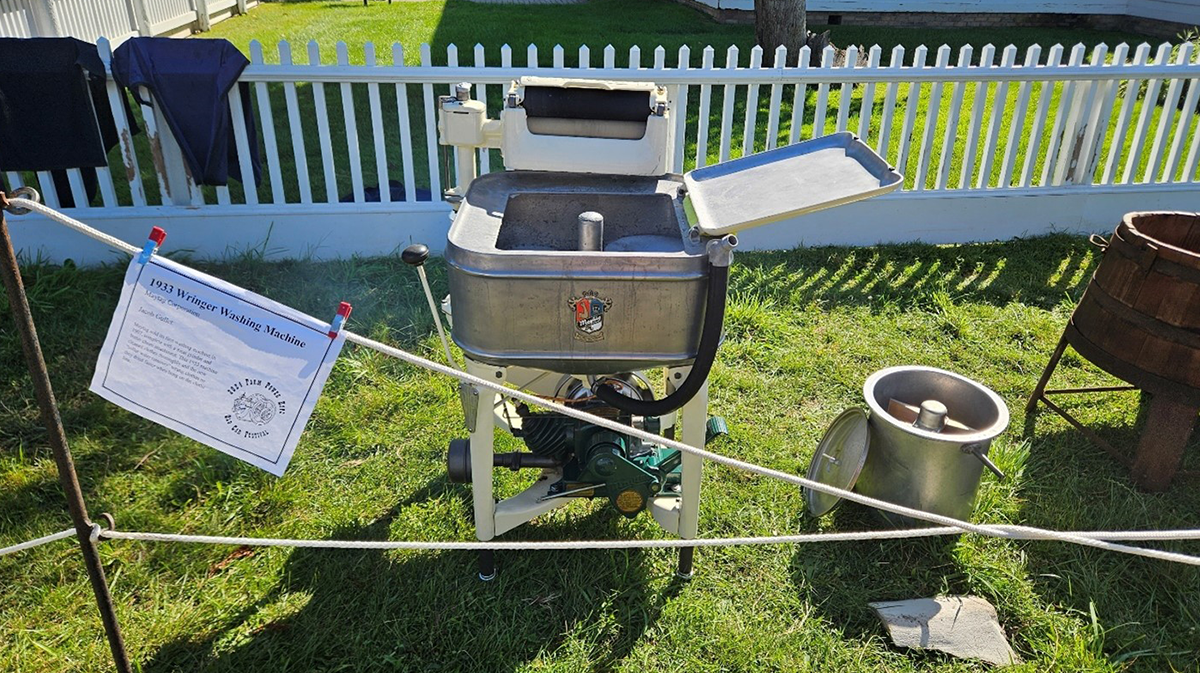
Small engines, including the one powering this early 1930s Maytag washing machine, were demonstrated at the Ford Home. / Photo by Matt Anderson
Automobile engines weren’t the only featured powerplants. Once again in 2024, the Early Engine Club put together a farm power expo at the Ford Home. Antique hit-and-miss engines, a Ford Model T powering small machines, and even a Model T converted into a tractor demonstrated the internal combustion engine’s abilities beyond motorized transportation. At the nearby Bagley Avenue Workshop, our own presenters regularly demonstrated a replica of Henry Ford's "Kitchen Sink” Engine, which powered Ford’s early ambitions toward automobile manufacturing.
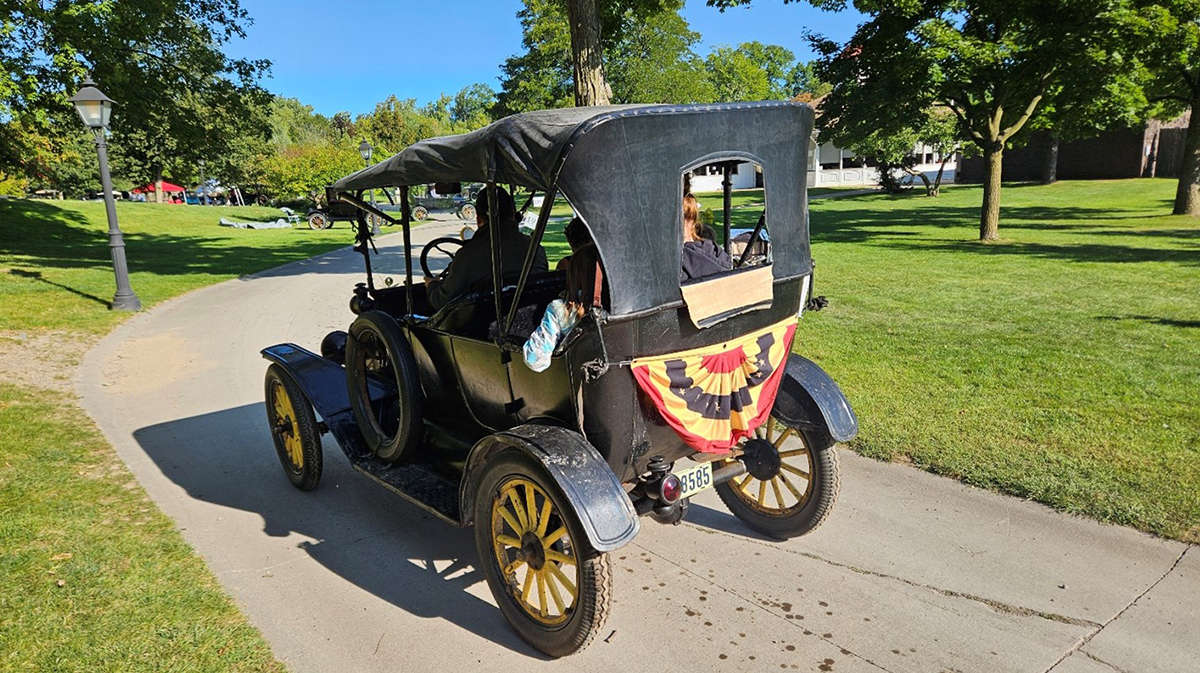
This 1916 Ford Model T, still running and still in the same family 108 years later, won a Curator’s Choice award. / Photo by Matt Anderson
As is a longstanding tradition, this year’s Old Car Festival included several cars that were judged for vehicle class awards based on authenticity, quality of restoration work, and care with which each car was maintained. First-, second-, and third-place prizes were awarded in eight classes, and one overall Grand Champion was selected for the festival. This year’s Henry Austin Clark, Jr., Grand Champion Award went to a 1932 Chevrolet Confederate Phaeton. We also presented two Curator’s Choice Awards to the best-preserved unrestored vehicles. Winners included a 1913 Oakland Model 40 Touring and a 1916 Ford Model T Touring. The complete list of our 2024 Old Car Festival award winners is available here
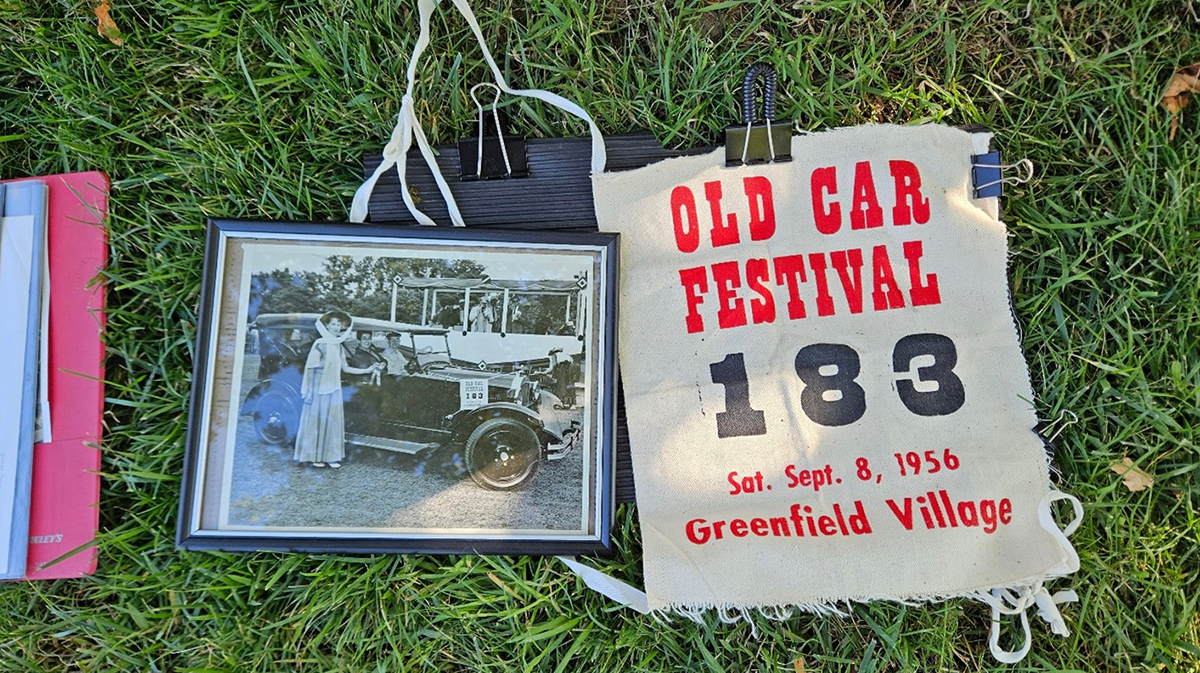
Old Car Festival is a tradition. This photo and banner are from the 1956 show, attended by a 1924 Dodge Brothers Series 116 that was here again in 2024. / Photo by Matt Anderson
We like to think that history comes alive in Greenfield Village every day, but rarely are the sights, sounds and smells of the past so fully resurrected as they are with the veteran motor vehicles of Old Car Festival. It’s an experience to savor year after year.
Matt Anderson is curator of transportation at The Henry Ford.
Protecting Pet Passengers with Sleepypod

Sleepypod carriers are designed to protect pets while traveling inside the family car. / THF185389
Improvements in automotive safety came gradually. Dodge Brothers crashed its early cars into brick walls to evaluate their strength during the mid-1910s. Ford offered laminated safety-glass windshields on its Model A cars in the late 1920s. And Chrysler and Plymouth models featured hydraulic brakes from their introductions in 1924 and 1928, respectively. But focus on seat belt use and scientific crash testing with anthropomorphic dummies didn’t come until the 1950s.
Continue ReadingFerris Bueller’s Faux Ferrari: A Replica with Real History

Like an actor cast in a role, this 1985 Modena Spyder California was chosen to play the part of a Ferrari 250 GT California Spyder in the movie Ferris Bueller’s Day Off. / Photo by Matt Anderson
For those who haven’t visited Henry Ford Museum of American Innovation in recent months, we have a wonderful new display space created in partnership with the Hagerty Drivers Foundation. Each year, we’ll share a couple of significant automobiles included on the foundation’s National Historic Vehicle Register. The (currently) 32 vehicles on the register each made a lasting mark on American history—whether through influence on design or engineering, success on the race track, participation in larger national stories, or starring roles on the silver screen.
Our first display vehicle is Hollywood through and through. It’s a “1961 Ferrari 250 GT California Spyder” (those quotes are intentional) used in the 1986 Gen-X classic Ferris Bueller’s Day Off. Those who’ve seen the film know that the car is a crucial part of the plot—ferrying Ferris, Sloane Peterson, and Cameron Frye around Chicago; threatening to expose their secret skip day; and forcing a difficult conversation between Cameron and his emotionally distant father.
In true movie fashion, though, not all is what it appears to be.
This 1958 Ferrari 250 GT California is the real thing, as featured in Henry Ford Museum’s Sports Cars in Review exhibit in 1965. / THF139028
The Ferrari 250 is among the most desirable collector cars in the world. GT street versions sell at auction for millions of dollars. And GTO competition variants—well, the sky’s the limit. Even in the mid-1980s, these autos were too pricey for film work—particularly when the plot calls for the car to be (spoiler alert) destroyed. Instead, Ferris Bueller director John Hughes commissioned three replicas for the shoot: two functional cars used for most scenes, and a non-runner destined to fly out the back of Mr. Frye’s suburban Chicago garage.
Replica cars were nothing new in the 1980s. For years, enterprising manufacturers had been offering copies of collector cars that were no longer in production and too expensive for most enthusiasts. The coveted Duesenberg Model J is a prime example, having been copied by replica manufacturers for decades. Some replica cars were more about convenience than cost. Glassic Industries of West Palm Beach, Florida, produced fiberglass-bodied copies of the Ford Model A with available niceties like automatic transmissions and tape decks. Occasionally, the line between “real” and “replica” got blurry. Continuation cars like the Avanti II (based on Studebaker’s original) or post-1960s Shelby Cobras (based on Carroll Shelby’s racing sports cars) were sometimes built with formal permission or participation from the original automakers.
So, if the Ferris Bueller car at The Henry Ford isn’t a real Ferrari, then what is it?
The replica’s builder, Modena Design & Development, was founded in the early 1980s by Californians Neil Glassmoyer and Mark Goyette. When John Hughes read about Modena in a car magazine, he called the firm. As the story goes, Glassmoyer initially hung up on the famous writer/director—believing that it had to be a prank. Hughes phoned again, and Modena found itself with a desirable movie commission. Paramount Pictures, the studio behind Ferris Bueller, leased one car and bought two others.
The Modena replicas featured steel-tube frames and Ferrari-inspired design cues like hood scoops, fender vents, and raked windshields. While the genuine Ferrari bodies used a blend of steel and aluminum components, Modena’s bodies were formed from fiberglass—purportedly based on a British MG body and then fine-tuned for a more Ferrari-like appearance.
The replica Ferrari’s V-8 was sourced from a 1974 Ford Torino, not too different from these 1973 models. / THF232097
The most obvious differences were under the cars’ skin. Rather than a 180-cubic-inch Ferrari V-12, the Modena at The Henry Ford features a 302-cubic-inch Ford V-8 (originally sourced from a 1974 Ford Torino). While the Ford engine was rated at 135 horsepower from the factory, this one has been rebuilt and refined—surely capable of greater output now. And instead of the original Ferrari’s four-speed manual gearbox, the Modena has a Ford-built three-speed automatic transmission. (According to lore, actor Matthew Broderick wasn’t comfortable driving a manual.)
After filming wrapped, the leased car was sent back to Modena’s El Cajon, California, facility. After some work to repair damage from a stunt scene, the car was sold to the first in a series of private owners. By 2003, this beloved piece of faux Italiana/genuine Americana had been relocated to the United Kingdom. The current owner purchased it at auction in 2010 and repatriated the car to the United States. The Modena was much modified over the years, so the current owner had it carefully restored and returned to its on-screen appearance—as you see it today.
Imitation can be the sincerest form of flattery, but it can also be the quickest route to a lawsuit. Following the release of Ferris Bueller’s Day Off, Ferrari sued Modena Design & Development (along with other replica builders). The matter was settled out of court when Modena agreed to make some minor changes per the Italian automaker’s specifications. Replica production then resumed for a few more years.
The Modena Spyder California may not be a real Ferrari, but it’s certainly a real pop-culture icon. That’s reason enough to include it on the National Historic Vehicle Register, and to celebrate it at The Henry Ford.
Matt Anderson is Curator of Transportation at The Henry Ford.
Henry Ford Museum, Europe, 1980s, 20th century, Illinois, California, by Matt Anderson, popular culture, movies, cars
Early American Luxury at 2022 Old Car Festival

Banners with vintage Lincoln artwork welcomed visitors to the 2022 Old Car Festival at Greenfield Village. / Photo by RuAnne Phillips
We observed a beloved late-summer tradition September 10–11, 2022, with Old Car Festival, our annual celebration of automobiles built between the 1890s and 1932. First held in 1951, Old Car Festival is the longest-running antique automobile show in the United States. (Though we should probably put an asterisk on that, thanks to 2020, when Old Car Festival—like most events—was canceled.)
Luxury was often synonymous with a higher cylinder count. Cadillac delivered with this 1915 V-8 touring car. / Photo by Matt Anderson
Each year, we turn our spotlight on a special make, model, individual, or theme. February 2022 brought the 100th anniversary of Ford Motor Company’s acquisition of Lincoln Motor Company, so it seemed fitting to feature the broader subject of “Early American Luxury.” (We’d already celebrated Lincoln specifically at this year’s Motor Muster.) Certainly, this theme includes Lincoln, but it also encompasses names like Packard, Cadillac, LaSalle, Pierce-Arrow, and Peerless. These are the marques that defined the very term “luxury car” in the early decades of the 20th century.
Detroit Central Market housed a selection of luxury vehicles from show participants and from The Henry Ford’s own collection. / Photo by Matt Anderson
This year was our first opportunity to incorporate the Detroit Central Market building into Old Car Festival activities. We took advantage of the spacious new structure to show select upmarket American cars drawn from show participants and from The Henry Ford’s own collection. Among the museum’s cars on view were a 1915 Cadillac Type 51 touring car, representing the first mass-produced V-8 automobile, and a 1923 Lincoln Model L touring car that once belonged to Thomas Edison. We also showed our 1922 Detroit Electric coupe. The little coupe might not have seemed so impressive alongside the big touring cars, but there was a time when electric automobiles were purposely marketed to well-to-do women.
This 1915 Packard Twin Six (Packard’s term for its V-12 engine) embodies our “Early American Luxury” theme. / Photo by Matt Anderson
Several magnificent participant cars rounded out our Central Market display. From Packard, we had a 1915 Twin Six touring car and a 1927 Series 626 sedan. From Franklin, we had a 1931 Series 151 sedan. Auburn—part of E.L. Cord’s Auburn-Cord-Duesenberg empire—was represented by a pair of beautiful 1929 models, including a cabriolet and one of the company’s beloved boat-tail speedsters. Our special exhibit wasn’t limited to exclusive marques. Luxury cars for customers of (relatively) more modest means were represented by a 1928 Studebaker President sedan and a 1930 LaSalle coupe.
Model T cars, wagons and trucks were everywhere at Old Car Festival, including this 1924 depot hack parked near Sarah Jordan Boarding House. / Photo by RuAnne Phillips
We had more than 730 vehicles registered for this year’s show. Automobiles, station wagons, trucks, bicycles, and even a few military vehicles were spread throughout Greenfield Village over the weekend. Visitors could enjoy the sights and sounds of a 1910s ragtime street fair along Washington Boulevard. They could attend a 1920s-era community garden party near Ackley Covered Bridge. They could watch the Canadian Model T assembly team put together a Ford automobile in mere minutes. Or they could hear about wartime struggles on the Western Front outside Cotswold Cottage. At the Ford Home, near the village entrance, Old Car Festival visitors could take in an exhibition of tractors and internal-combustion engines that took some of the backbreaking labor out of early-20th-century farming. For festival participants in a matrimonial mood, our friends at Hagerty arranged a Drive-Thru Vow Renewals experience. Registered show-car owners could drive their antique vehicles past the makeshift altar in front of Edison Illuminating Company’s Station A and “re-light” their nuptials.
Martha-Mary Chapel provided an inspiring backdrop for cars on the Village Green. It also housed a series of special programs throughout the weekend. / Photo by RuAnne Phillips
Speaking of altars, Martha-Mary Chapel hosted several programs and presentations during Old Car Festival. Tom Cotter, author and host of the popular web series Barn Find Hunter, presented twice during the weekend. On Saturday, he went behind the scenes of his car-seeking show with “A Barn-Finding Life.” On Sunday, Cotter recalled the 3,000-mile journey chronicled in his book Ford Model T Coast to Coast. On both days, longtime festival participant Daniel Hershberger discussed early auto touring and roadside camping. Hershberger dedicated his talks to the memory of Randy Mason, a former curator of transportation at The Henry Ford who passed away earlier this year. Also on both days, historian Joseph Boggs looked at the fascinating relationship between automobiles and 1920s Prohibition. Cars factored into both sides of the equation—used by rumrunners and law enforcement officers alike.
Of special interest were two panel discussions on early American luxury cars, held on Saturday and Sunday. Through the generous support of the Margaret Dunning Foundation, we brought together three experts in the field: Bob Casey, retired curator of transportation at The Henry Ford; David Schultz, president of the Lincoln Owners Club; and Matt Short, former curator at the Auburn-Cord-Duesenberg Automobile Museum and former director of America’s Packard Museum. Our panelists discussed the innovators, manufacturers, and automobiles that defined luxury motoring into the 1930s. Their Sunday session was livestreamed and can be viewed here on The Henry Ford’s Facebook page.
Select participating vehicles at Old Car Festival were judged for various class awards. From those winners, one grand champion was selected each day. / Photo by RuAnne Phillips
Visitors may not be aware of a special distinction (apart from chronology) that separates Old Car Festival from our Motor Muster show. Participants at Old Car Festival can choose to have their vehicles judged by a team of vintage-automobile experts. The judges determine Vehicle Class Awards based on authenticity, quality of the restoration work, and care with which each car is maintained. First-, second-, and third-place prizes are awarded in 11 different classes. One overall Grand Champion is selected on each day of the festival. Additionally, two Curator’s Choice Awards are presented to unrestored vehicles, and guests and participants are invited to vote for their favorites in the People’s Choice Awards. The full list of our 2022 award winners may be viewed here.
Old Car Festival includes trucks, too. Commercial vehicles line Christie Street during the event. / Photo by RuAnne Phillips
Great crowds, good weather, and impressive vehicles made for a perfect show in 2022. While it’s always hard to say goodbye to summer, Old Car Festival is certainly a fine way to do it. We look forward to next year’s event already.
Matt Anderson is Curator of Transportation at The Henry Ford.
Michigan, Dearborn, 21st century, 2020s, Old Car Festival, luxury cars, Greenfield Village, events, cars, car shows, by Matt Anderson
Barney Korn: Tether Car Craftsman

Barney Korn’s work is featured in The Henry Ford’s exhibit Driven to Win: Racing in America. / Photo by Matt Anderson
In the 1930s and 1940s, race fans who didn’t have the budget or the bravery for full-size auto racing could find big thrills in small scale through the world of tether cars. These gas-powered model cars were raced by adults in organized competition. The models either raced against the clock, running in circles while tethered to a pole, or they raced against each other on a scaled-down board track fitted with guide rails.
The fastest tether cars topped 100 miles per hour—real miles, not scale miles—which explains another name given to them: spindizzies. (Imagine watching a little car zooming around a pole and the name makes perfect sense.) Though they look like toys, these models could be expensive. By the time you bought the car, the engine, the tools, and the accessories, you could be looking at more than $100—at a time when you could by a Ford DeLuxe Convertible for well under $1,000. At the hobby’s peak, some 25 major manufacturers and hundreds of individual builders produced tether cars. But few makers matched the skill and craftsmanship of Barney Korn.
Barney Korn’s skill was apparent from his high school days, as when he built this working engine in shop class. / THF160779
Bernard Barney Korn was born in Los Angles on April 24, 1903. He showed his modeling talents at an early age, building an elaborate water-cooled model engine as a project for his high school shop class. After high school, Korn honed his skills in part by working as a machinist for aviation innovator Howard Hughes, whom he joined in 1924.
One of Barney Korn’s “Indianapolis” models, with the hood removed to expose the single-cylinder gas engine. / THF157084
As tether cars became more popular, Barney Korn joined the booming business and formed B.B. Korn Specialty Manufacturing Company in 1939. His first production model, the “Meteor,” was also his rarest. Only 18 examples are known to have been made. The following year, Korn began production of his best-known and, many would say, best-looking model: the “Indianapolis.” Based on real Indianapolis 500 race cars of the time, Korn’s “Indianapolis” was handsome and well proportioned. It was a big model, with an overall length over 20 inches. Many were also exceptionally detailed. The “Liberty Special” car even had a working compass in its dashboard! But the “Indianapolis” was rare too. It’s believed that Korn produced fewer than 70 examples in total. Most featured rear-wheel drive trains and aluminum bodies, though a few had lightweight magnesium bodies. When materials were restricted during World War II, Korn mixed and matched aluminum and magnesium components as needed.
Korn’s working dynamometer measured engine performance in his model cars. / THF159749
Barney Korn used precision tools, molds, and patterns to build his model cars. In a particularly impressive feat, Korn even built a working dynamometer to test his cars’ performance. Like full-size dynamometers, Korn’s version was basically a treadmill for engines. It allowed a model car’s drive wheels to spin while the car itself remained stationary. Korn’s dyno measured the power and torque of the .60-cubic inch engine as it delivered power to the wheels. The little dynamometer was even adjustable to accommodate both front and rear-wheel drive models.
This unfinished Korn “Indianapolis 29” kit would have appealed to the budget-conscious tether car buyer. / THF162913
The B.B. Korn Manufacturing Company provided a few options for budget-conscious buyers. Instead of a standard “Indianapolis” model, they could purchase one of Korn’s “Indianapolis 29” cars. Everything about the “29” series was smaller—from the .29-cubic inch engines (source of the name), to the dimensions, to the all-important price tags. Those wanting to save even more could opt for an unassembled “Indianapolis 29” kit rather than a fully assembled car. With the kit, it was up to the buyer to finish rough edges on the balsa wood body, and to source an engine separately.
Barney Korn’s tether cars were beautifully made and carefully detailed, but that quality came at a price—in dollars and in performance. Korn’s models were too expensive for amateur hobbyists and too slow for serious racers. Poor sales made the B.B. Korn Manufacturing Company unsustainable, and it closed just a few years after it opened.
Barney Korn went on to a career in modelmaking for special effects work in films. His detailed miniatures can be seen in movies like To Please a Lady, a 1950 racing melodrama staring Clark Gable and Barbara Stanwyck, and Moby Dick, the 1956 adaptation of Herman Melville’s novel directed by John Huston. In the early 1980s, Korn even built a few improved versions of his original tether car designs.
Barney Korn died in Los Angeles on October 23, 1996, but his craftsmanship survives. Replicas of Korn’s models are readily available today, and originals are highly prized by collectors. It’s a proud legacy for a talented artist who some regard as the Leonardo da Vinci of the tether car hobby.
Explore Further
“Barney Korn: Tether Car Craftsman” expert set
“Tether Cars: Big Thrills in Small Scale” expert set
Driven to Win: Racing in America exhibit information
Artifacts related to tether cars in our Digital Collections
Matt Anderson is Curator of Transportation at The Henry Ford.
Additional Readings:
- 2016 Le Mans Class-winning Ford GT Race Car, On Loan from Ford Motor Company
- 1901 Ford "Sweepstakes" Race Car
- 1902 Ford "999" Race Car, Built by Henry Ford
- 1906 Locomobile "Old 16" Race Car
engineering, engines, making, Henry Ford Museum, Driven to Win, toys and games, by Matt Anderson, cars, racing
Celebrating the National Historic Vehicle Register

America’s car culture is a subject for music, movies, and postcards—and for serious study and preservation. / THF104062
There’s an exciting new changing exhibit in Henry Ford Museum of American Innovation. In partnership with our friends at the Hagerty Drivers Foundation, we’re spotlighting some of the nation’s most significant automobiles and trucks. Some of these vehicles introduced new ideas in engineering or design, others found glory on the race track, and a few lit up the silver screen. In all cases, these vehicles left a mark on American history important enough to earn them a place on the National Historic Vehicle Register.
We inaugurate this collaborative display with a car from the world of popular culture. For those of us who were teens in the 1980s, the movies of writer-director John Hughes were inescapable. Films like Sixteen Candles, The Breakfast Club, Weird Science, and Pretty in Pink captured the Reagan-era teenage zeitgeist—and timeless teenage angst—to a T. But for self-styled Gen-X slackers, one film in the Hughes catalog stands above the rest: Ferris Bueller’s Day Off.
There’s probably no need to summarize the well-known plot (see here if you disagree). Suffice it to say, high school senior Ferris (Matthew Broderick) convinces best friend Cameron (Alan Ruck) and girlfriend Sloane (Mia Sara) to join him on his own personal skip day through Chicago. The plot really gets rolling, so to speak, when Ferris convinces Cameron to let them take his father’s 1961 Ferrari 250 GT California on their adventures. It doesn’t end well. The Ferrari becomes the target of Cameron’s longstanding anger with his father, and its accidental destruction forces some serious interpersonal growth.
This (genuine) 1958 Ferrari 250 GT California was part of Henry Ford Museum’s 1965 Sports Cars in Review exhibit. / THF139028
We’re delighted to be able to exhibit that Ferrari. Well, not that Ferrari… the one that got destroyed. For that matter, what we’re showing isn’t even a Ferrari. It’s a 1985 Modena Spyder California—an authentic-looking replica built by Modena Design & Development in El Cajon, California. It’s one of three Modena replicas used in shooting the movie. (Even in the mid-1980s, a genuine Ferrari 250 GT was too valuable to risk in film work.) This beloved pop-culture car is a playful way to kick off our celebration of a serious project: the National Historic Vehicle Register.
The National Historic Vehicle Register has its roots in the Historic American Engineering Record (HAER). Established jointly in 1969 by the National Park Service, the American Society of Civil Engineers, and the Library of Congress, HAER documents significant sites and structures associated with America’s engineering and industrial history. According to established HAER guidelines, nominated structures are documented with written reports, photographs, and technical drawings. These materials are then deposited in the Library of Congress. Generally, a listing in the HAER does not, in itself, protect a structure from possible demolition. It does, however, “preserve” that structure for the future via HAER’s extensive documentary materials.
HAER has documented buildings, bridges, and even airplanes, but it’s never documented cars. Recognizing the need for some similar mechanism to record significant automobiles and trucks, the Historic Vehicle Association (HVA) was formed in 2009. Modeling itself on HAER, the HVA had four founding principles:
- To document and recognize significant vehicles in a national register
- To establish and share best practices for the care and preservation of significant vehicles
- To promote the historical and cultural importance of motor vehicles
- To protect automotive history through affiliations with museums and academic institutions, through educational programs, and through support of relevant legislation
The Historic Vehicle Association, in collaboration with the U.S. Department of the Interior, established the National Historic Vehicle Register (NHVR) in 2013 and, in January 2014, it added the first car to its list. HVA selected a 1964 Shelby Cobra Daytona Coupe, one of six built by Carroll Shelby and his Shelby American team to compete in sports car races. Apart from Mr. Shelby himself, the Cobra Daytona Coupe was also developed with legendary racing figures like Pete Brock, Ken Miles, and Phil Remington.
CSX2287, the first Shelby Cobra Daytona Coupe, won the 12 Hours of Sebring in 1964. Fifty years later, it became the first entry on the National Historic Vehicle Register. / THF130368
We should pause to note that, of necessity, the National Historic Vehicle Register contains individual cars. The register does not list the Cobra Daytona Coupe as a model. Rather, it specifically includes chassis number CSX2287—the first of the six built, and the only one built completely at Shelby American’s Venice, California, shop. CSX2287 won the GT class at the 1964 Sebring 12-Hour race, competing as number 10, with drivers Dave MacDonald and Bob Holbert. The car later set 27 national and international land speed records at the Bonneville Salt Flats, with Craig Breedlove at the wheel. CSX2287 is now in the collections of the Simeone Foundation Automotive Museum in Philadelphia, Pennsylvania.
Following its selection, the Cobra Daytona Coupe—like all subsequent vehicles on the register—was thoroughly documented for the NHRV. Specialists researched the car through written documents and spoken interviews, they photographed it from multiple angles, and they measured the car using sophisticated laser scanners. (You can learn more about the scanning process in this clip from The Henry Ford’s Innovation Nation.) The resulting materials were then sent to the Library of Congress for long-term preservation.
The Historic Vehicle Association was founded with philanthropic support from Hagerty, the world’s largest specialist insurance provider for historic vehicles. In more recent years, the work of the HVA has been folded into the Hagerty Drivers Foundation, which manages the National Historic Vehicle Register with the U.S. Department of the Interior.
The Marmon Wasp driven by Ray Harroun, winner of the 1911 Indianapolis 500. / THF229391
To date, more than 30 vehicles have been added to the National Historic Vehicle Register. There are celebrated race cars like the 1907 Thomas Flyer that won the 1908 New York to Paris Automobile Race, the 1911 Marmon Wasp that won the first Indy 500, and one of NASCAR’s “Fabulous Hudson Hornets” driven by Herb Thomas.
Volkswagen’s groundbreaking Type 2 Transporter is represented on the NHVR by a van that served a higher purpose: supporting Black Americans in the Civil Rights Movement. / THF105564
There are vehicles that participated in large national events, like a 1918 Cadillac employed by the U.S. Army in World War I, or a 1966 Volkswagen Transporter used in humanitarian efforts supporting Black Americans on Johns Island, South Carolina, during the Civil Rights Movement, or a 1969 Chevrolet Corvette driven by Apollo astronaut Alan Bean, who landed on the Moon in November 1969.
The 1964 Chevrolet Impala lowrider is a car culture icon, illustrated by this remote-controlled model. / THF151539
The wide world of American car culture is wonderfully represented by a 1932 Ford V-8 hot rod built by Bob McGee, a 1951 Mercury Coupe modified for Masato Hirohata by “King of Kustomizers” George Barris, and the pioneering 1964 Chevrolet Impala lowrider “Gypsy Rose,” customized by Jesse Valadez.
Preston Tucker’s 1948 Tucker 48 made a mark in life and on screen. / THF135047
The register doesn’t overlook the automobile’s contributions to popular culture. Apart from the replica Ferrari used in Ferris Bueller’s Day Off, the list includes a 1968 Ford Mustang driven by Steve McQueen during the influential car chase in Bullitt, and a 1981 DeLorean DMC-12 that carried Michael J. Fox’s Marty McFly to 1955 before returning him back to the future. Preston Tucker’s 1947 Tucker 48 prototype is something of a movie car too. Yes, it inspired a real-life production vehicle, but it also inspired the 1988 film Tucker: The Man and His Dream, starring Jeff Bridges.
The 15 Millionth Ford Model T traveled from Greenfield Village to the National Mall in April 2018, after it was added to the NHVR. / Photo courtesy Hagerty Drivers Foundation
Some of you may be wondering if anything from The Henry Ford’s collections is listed on the National Historic Vehicle Register. I’m happy to report that, yes, we are represented by (what else) a Ford Model T added to the list in 2018. It’s not just any T, of course, but the 15 Millionth Ford Model T, which was the ceremonial “last” Model T built before Ford ended production in favor of the 1928–1931 Model A. Like most of the vehicles added to the register, our 15 Millionth Model T traveled to Washington, D.C., where it was displayed on the National Mall—to honor the car, but also to draw attention to the NHVR and the importance of preserving America’s automotive heritage. The NHVR research team also produced a 23-minute documentary on the Ford Model T and its enormous influence.
The register continues to grow. Likewise, The Henry Ford will continue to display a rotating selection of register cars in the years ahead. It’s a fun way to celebrate America’s car culture, but it’s also an opportunity to recognize the important and ongoing work of the National Historic Vehicle Register.
Matt Anderson is Curator of Transportation at The Henry Ford.
Model Ts, race cars, racing, popular culture, movies, by Matt Anderson, Henry Ford Museum, cars
Celebrating Lincoln at the 2022 Motor Muster

Lincoln was in our Motor Muster spotlight, but that didn’t mean we couldn’t enjoy this beautiful 1953 Cadillac Series 62 convertible. Perfect weather added to the show’s success. / Photo by Matt Anderson
It was a Motor Muster to remember as more than 600 cars, trucks, motorcycles, and bicycles—all dating from 1933 to 1978—gathered in Greenfield Village over the weekend of June 18–19, 2022. We couldn’t have asked for better weather, with both Saturday and Sunday boasting sunny skies and mild temperatures in the mid-70s.
It’s been a century since Ford purchased Lincoln—a perfect time to bring out two Lincoln Continentals from The Henry Ford’s collection: a 1941 convertible and a 1964 limousine. / Photo by Matt Anderson
Our spotlight this year fell on Lincoln Motor Company. One hundred years ago, on February 4, 1922, Henry and Wilfred Leland sold their struggling firm to Henry and Edsel Ford. After that shaky start, Lincoln thrived under Ford management—particularly under the leadership of Edsel Ford—and produced designs and nameplates that continue to inspire today’s enthusiasts.
Detroit Central Market featured Lincoln Continentals from every styling generation within Motor Muster’s 1933–1978 time period. / Photo by Matt Anderson
This was our first Motor Muster with the Detroit Central Market building, which opened earlier this year. We took full advantage of the beautiful structure, using it as a showcase for our Lincoln Motor Company theme. With generous assistance from some of our participants, and by drawing on The Henry Ford’s own collections, we assembled a complete set of at least one Lincoln Continental from every styling generation produced in our Motor Muster time frame of 1933 to 1978. Highlights included our 1941 Lincoln Continental convertible—a personal car of Edsel Ford who, with designer Bob Gregorie, created the original Continental—and our 1964 Lincoln Continental stretch limousine modified for Pope Paul VI. Other special vehicles included a full set of Lincoln’s top-of-the-line Mark-series Continentals representing the Mark III, VI, and V models. For good measure, we also included a couple of Continental Mark II cars—even though, strictly speaking, they’re not Lincolns.
This 1977 Ford Bronco looked just fine posed in front of the Logan County Courthouse where—speaking of Lincolns—Abraham Lincoln tried cases in the 1840s. / Photo by Matt Anderson
Our familiar decade vignettes returned for 2022. We recognized the 1930s with a re-created Civilian Conservation Corps camp, cooking demonstrations, and a wonderful selection of blues music by singer-guitarist Robert Jones. For the 1940s, we honored American efforts during World War II with a re-created wartime scrap drive and a horse-drawn milk delivery wagon—an appropriate fuel-saving measure and a reminder of days when the local dairy delivered right to your doorstep.
Outboard boat motors—and even a few boats—highlighted the “Tailfins and Two-Tones” boating display at Suwanee Lagoon. / Photo by Matt Anderson
The 1950s and 1960s had three interesting expressions at Motor Muster this year. We had our suburbia-inspired selection of vintage lawn mowers, as well as regular musical performances of ’50s hits by the Village Cruisers. New for 2022 was our “Tailfins and Two-Tones: Outboard Boating’s Golden Age” display on the banks of Suwanee Lagoon. Some of our show participants staged a selection of vintage outboard boat motors, along with a small flotilla of (trailered) motorboats exhibiting the same bright colors and tall tailfins seen on automobiles of the time.
Something truly unusual: a 1978 VAZ 21011 sedan built in the Soviet Union—but flying Ukrainian flags in support of that besieged nation. / Photo by Matt Anderson
We celebrated the 1970s with another trio of programs. Costumed participants enjoyed a 1976 Bicentennial picnic near Ackley Covered Bridge. The band Classic Gold provided mini concerts of classic rock hits at the nearby gazebo. And, at the Herschell-Spillman Carousel, the vintage band organ pumped out music of a different vintage as it played hits by ’70s Swedish pop phenom ABBA throughout the weekend.
Regular pass-in-review programs provided expert commentary on participating cars, like this 1955 Pontiac Star Chief. / Photo by Matt Anderson
As always, Motor Muster visitors could choose to walk throughout Greenfield Village to see the cars arranged in chronological groupings, or they could find a seat in the bleachers on Main Street and let the cars come to them. Our pass-in-review programs, held throughout the weekend, had participant cars parading past the reviewing stand where expert narrators provided commentary on the various vehicles—design elements, engineering achievements, and personal stories from the collectors who shared their cars with us at the show.
After a couple of unusual years, it was good to be back at a Motor Muster that felt so close to normal. We’ve missed the cars for sure, but we’ve missed the camaraderie even more. Ask any of the show’s participants—the cars might draw us into this hobby, but it’s the stories and the friendships that keep us hooked.
Matt Anderson is Curator of Transportation at The Henry Ford.
Michigan, Dearborn, 21st century, 2020s, Motor Muster, Greenfield Village, Ford Motor Company, events, cars, car shows, by Matt Anderson
Frank Kulick: Early Ford Racer

Frank Kulick sitting in a 1910 Ford Model T race car. / THF123278
Frank Kulick (1882–1968) was a lucky man who beat rivals and cheated death on the race track. But his greatest stroke of luck may have been being in the right place at the right time. Born in Michigan, Kulick started his first job—in a Detroit foundry—at age 12. He was listed as a spring maker in the 1900 census. But in 1903 he was working for Northern Manufacturing Company—an automobile company founded by Detroit auto pioneer Charles Brady King.
That’s where Frank Kulick met Henry Ford.
Ford stopped by Northern to borrow a car. Impressed with young Kulick, Ford lured him to his own Ford Motor Company, where Kulick signed on as one of Ford Motor’s first employees. Kulick was there at Lake St. Clair in January 1904 when Henry Ford set a land speed record of 91.37 miles per hour with his “Arrow” racer. Not long after, Ford told Kulick, “I’m going to build you a racing car.” By that fall, Frank Kulick was driving to promote Ford Motor Company on race tracks and in newspapers.
Frank Kulick scored his early victories driving this four-cylinder Ford racer. Its engine consisted of a pair of two-cylinder (1903) Model A engines mated together. / THF95388
Kulick went head-to-head with drivers who became legends in American motorsport—people like Barney Oldfield, whose cigar-chomping bravado set the mold for racing heroics, and Carl Fisher, who established Indianapolis Motor Speedway in 1909 and the Indianapolis 500 two years later. Kulick firmly established his credentials with an improbable win at Yonkers, New York, in November 1904. Through skillful driving in the corners and a bit of good luck (which is to say, bad luck for his competitors), Kulick’s little 20-horsepower Ford pulled out a win against a 90-horsepower Fiat and a 60-horsepower Renault. Kulick covered a mile in 55 seconds—an impressive racing speed of 65 miles per hour.
Frank Kulick (second from right) and Henry Ford (third from left) were photographed in New Jersey with the Model K racer in 1905. / THF95015
Frank Kulick’s four-cylinder, 20-horsepower car was superseded in 1905 by a larger car with a six-cylinder, 60-horsepower engine. It was one of a series of cars using engines based on the six-cylinder unit that appeared in the Ford Model K. The bigger engine did not bring better results. Henry Ford himself drove one of the cars twice in the summer of 1905, chasing new land speed records on the New Jersey beach. But the car came up short each time.
With Kulick at the wheel, Ford tried again for a record at Ormond Beach, Florida, in January 1906—this time with the six-cylinder engine improved to 100 horsepower. But Kulick had trouble with the soft sand, and he managed no better than 40 miles per hour on the straightaway. (The record was broken at the Ormond Beach event—but by a steam-powered Stanley that hit 127.66 miles per hour.)
The end of the road for Ford’s six-cylinder racers nearly ended Frank Kulick’s career—and his life. It happened in October 1907, on the one-mile oval at the Michigan State Fairgrounds near Detroit. Kulick was trying to lap the dirt track in fewer than 50 seconds—a speed better than 72 miles per hour. His latest car was dubbed “666”—a name that simultaneously called attention to its cylinder count and paid homage to Henry Ford’s earlier “999.” In retrospect, that nefarious name was a bad omen.
Miraculously, Frank Kulick survived this crash in 1907, but it left him with a broken leg and a permanent limp. / THF125717
As Kulick was going through a turn on the fairgrounds oval, his rear wheel collapsed. Car and driver went careening off the track, through the fence, and down a 15-foot embankment. When rescuers arrived, they found Kulick some 40 feet from his wrecked racer. He was alive, but with his right kneecap fractured and his right leg broken in two places. Frank Kulick survived the crash, but his injuries healed slowly and imperfectly. He wore a brace for two years, and he walked with a limp for the rest of his life—his right leg having come out of the ordeal 1 ½ inches shorter than his left leg. The “666” was repaired, but it never competed again.
Henry Ford was horrified by Kulick’s accident, and he very nearly swore his company off racing for good. It wasn’t until 1910 that Kulick competed again under the company’s colors. By then, Ford Motor Company wasn’t building anything but the Model T, so Kulick naturally raced in a series of highly modified T-based cars. Arguably, his first effort in the renewed campaign was more show business than sport. Kulick went to frozen Lake St. Clair, northeast of Detroit, that February to challenge an ice boat. He easily won the match and earned quick headlines for the Model T.
Kulick posed in a Model T racer at the Algonquin Hill Climb, near Chicago, in 1912. / THF140161
Over the next two years, Kulick and his nimble Model T racers crossed the country competing—and frequently winning—road races and hill climbs. Despite Kulick’s success, Henry Ford remained lukewarm on racing. Ford Motor Company built nearly 70,000 cars in 1912 and still struggled to meet customer demand, so it certainly didn’t need the promotion—or problems—that came with an active motorsport program. Kulick later recalled that, after a race at Detroit in September 1912, Henry pulled $1,000 in cash from his pocket and told Frank, “I’ll give you that to quit racing.” Despite the generous offer (almost $30,000 in today’s dollars), Kulick continued a bit longer.
Frank Kulick may have started having second thoughts the next month. While practicing for the Vanderbilt Cup road race in Milwaukee, he grew concerned about the narrow roadway. There wasn’t enough room to pass another car without dipping into a ditch, so Kulick protested and dropped out of the contest. His concerns proved well founded when driver David Bruce-Brown was killed in the next round of practice.
It was the 1913 Indianapolis 500 that finally changed Kulick’s career path. Then in its third running, the Indy 500 was well on its way to becoming the most important race in the American motorsport calendar. Henry Ford was determined to enter Kulick in a modified Model T. But Indy’s rules specified a minimum weight for all entries. The Ford racer weighed in at less than 1,000 pounds—too light to meet the minimum. Indy officials rejected the modified T, and a frustrated Henry Ford reportedly replied, “We’re building race cars, not trucks.” With that, there would be no Ford car in the Indianapolis 500—in fact, there would be no major factory-backed Ford racing efforts for 22 years.
Kulick’s later career involved more genteel assignments, like driving the ten millionth Ford on a coast-to-coast publicity tour in 1924. Here, he takes a back seat to movie stars Mary Pickford and Douglas Fairbanks. / THF134645
Frank Kulick’s racing days were over, but he remained with Ford Motor Company for another 15 years. His assignments varied from research and development to publicity. In 1924, Kulick was charged with driving the ten millionth Ford Model T on a transcontinental tour from New York to San Francisco. Three years later, Kulick was called on to help celebrate the 15 millionth Model T. This time, rather than driving it across the country, Kulick—as one of Ford Motor Company’s eight senior-most employees—had the honor of helping stamp digits into the engine’s serial number plate. It was perfectly fitting that, as someone who’d done so much to promote the Model T through racing, Kulick was there to make his mark on the ceremonial last T. Kulick left Ford not long after that. He had done well investing in real estate, which afforded him a comfortable retirement.
Frank Kulick passed away in 1968. He survived to see Ford Motor Company achieve its great racing triumphs at Indianapolis and Le Mans during the “Total Performance” era. He also lived long enough to sit for an interview with author Leo Levine, whose 1968 book, Ford: The Dust and the Glory, remains the definitive history of Ford racing in the first two-thirds of the 20th century. Levine wrote a whole chapter on Frank Kulick—but then, Frank Kulick wrote a whole chapter in Ford’s racing history.
Matt Anderson is Curator of Transportation at The Henry Ford.
Additional Readings:
- Remembering Al Unser, Sr. (1939-2021)
- Eight Questions with Vaughn Gittin, Jr.
- Race Cars of Driven to Win
- 2016 Ford GT Full-Size Clay Model, 2014
Michigan, Model Ts, Indy 500, cars, by Matt Anderson, Ford workers, Ford Motor Company, Henry Ford, race cars, race car drivers, racing

